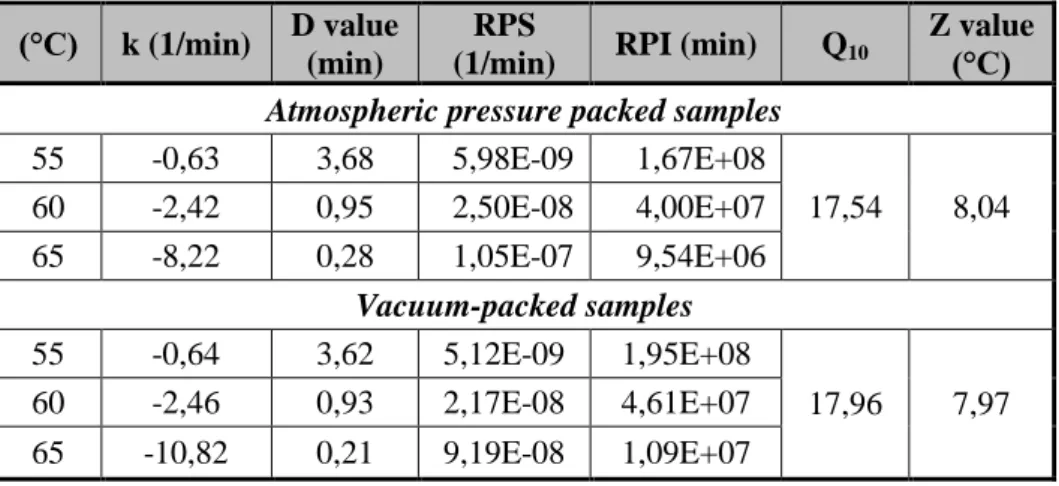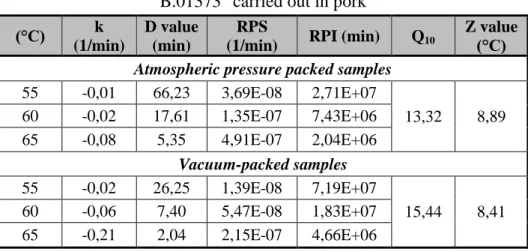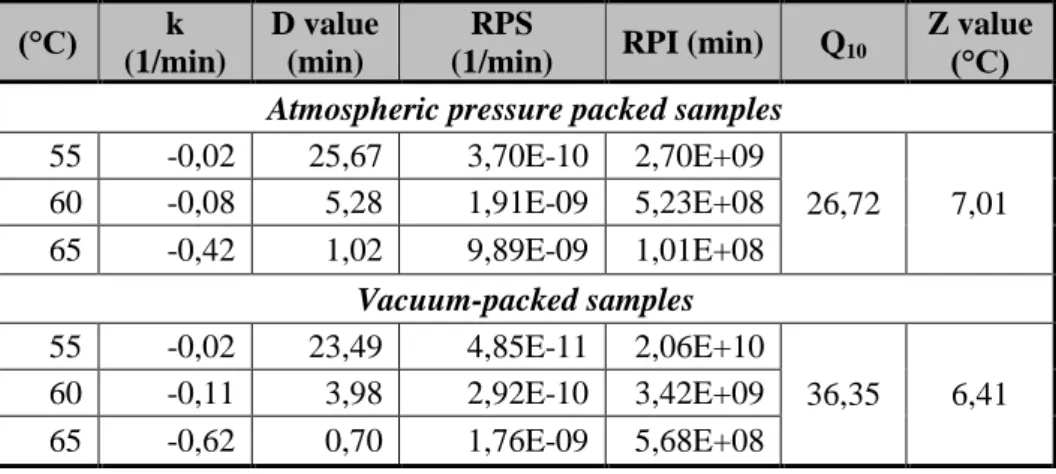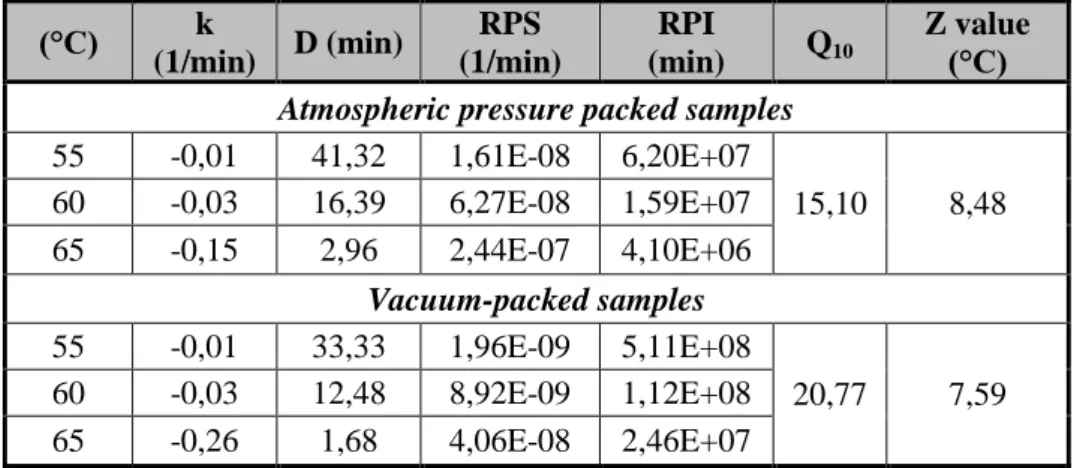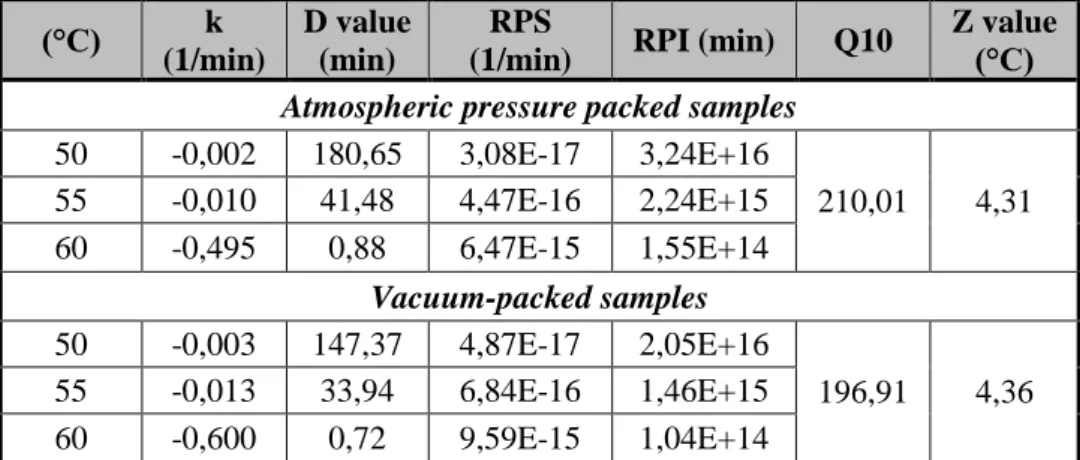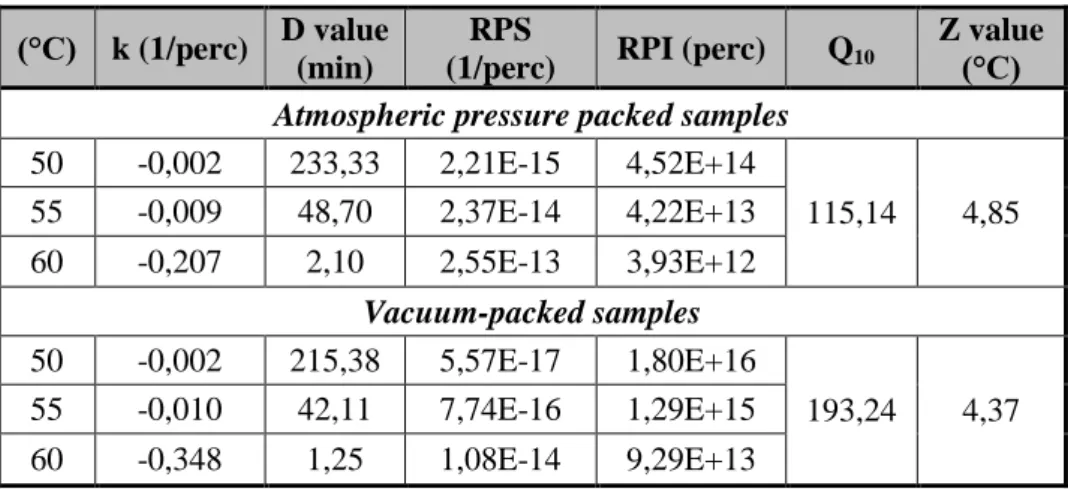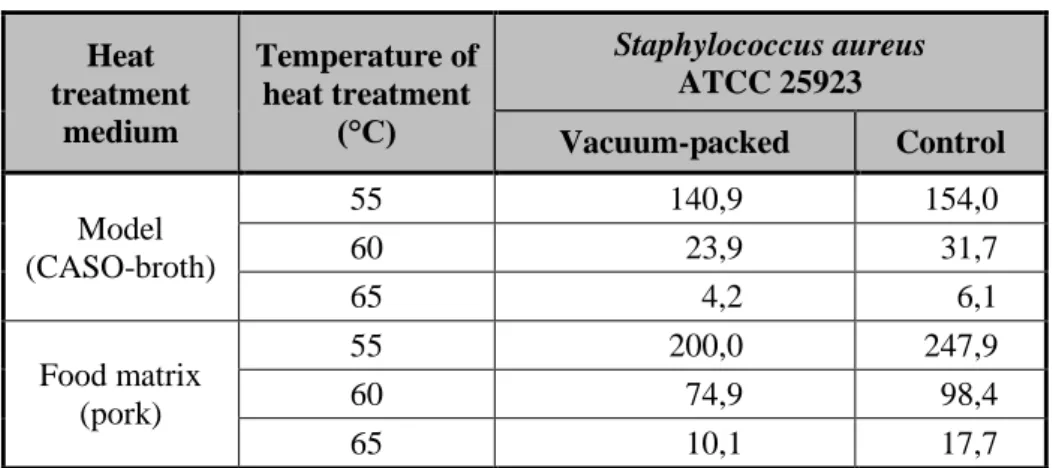THESES OF DOCTORAL (PhD) DISSERTATION
PETRA SZÜCS
MOSONMAGYARÓVÁR 2015
THESES OF DOCTORAL (PhD) DISSERTATION INSTITUTE OF FOOD SCIENCE
FACULTY OF AGRICULTURE AND FOOD SCIENCES UNIVERSITY OF WEST HUNGARY
Antal Wittmann Multidisciplinary Doctoral School of Plant, Animal and
Food Sciences
Gábor Pulay Doctoral Program in Food Science
Head of Doctoral School:
Prof. Dr. Miklós Neményi, CMHAS Head of Doctoral Program:
Prof. Dr. habil. Jenő Szigeti, CSc Dissertation Advisers:
Prof. Dr. habil. Jenő Szigeti, CSc Dr. Balázs Ásványi, PhD
Increasing the microbiological stability of foods by mild heat treatment (sous-vide technology)
Written by:
Petra Szücs
MOSONMAGYARÓVÁR 2015
2 1. INTRODUCTION
Due to the world population growth, human food supply and even the feeding faced a peculiar dichotomy: producing and processing the more food and feed material (biomass) per unit area in such a way as to have favorable nutritional indicators to consumers. As the result of urbanization, production, processing and consumption are both separated in time and space. Therefore, food production processes are unthinkable without preservation methods. To accomplish this, there is a great opportunity called sous-vide (French word for ’under vacuum’) technology, which is classified as a mild heat treatment. In our researches, we heat treated artificially preserved media and food matrices (minced pork and vegetable mix) which were both packed under vacuum and atmospheric pressure (control) modelling this mild heat treatment.
Our research objectives are summarized as follows:
We determined the effects of heat treatments generated by vacuum packaging and by circulation heat holder device on the mortality kinetics (mainly z-value, D-value, Q10 value, relative mortality rate and time) of species like Staphylococcus aureus, Listeria monocytogenes, and Zygosaccharomyces bailii which often appear in sous vide products.
Our further objective was to determine the minimal heat treatment parameters in accordance with sous-vide principles which can reduce the number of these species to a safe level.
3 2. MATERIALS AND METHODS
Our examinations were carried out in a certified food and water testing laboratory (accreditation number: NAT-1-1674/2012) operating at the Institute of Food Sciences of the Faculty of Agricultural and Food Science, University of West Hungary. In our studies, we investigated the thermal destruction of two food pathogenic bacteria, the Listeria monocytogenes NCAIM B.01373T type strain and the coagulase positive Staphylococcus aureus ATCC 25923 strain modelling the sous-vide technology in artificial medium and food matrix (pork meat). Untreated samples were used as control. Our tests were carried out at different temperatures but modelling the same conditions with Zygosaccharomyces bailii NCAIM Y.00954T yeast strain as well. In addition to the model medium, vegetable mix was used as food matrix.
We applied 55, 60 and 65 °C heat holding temperatures for Listeria monocytogenes and coagulase positive Staphylococcus aureus strains. In case of the Zygosaccharomyces bailii yeast strain, 50, 55 and 60 °C degrees were applied. As for controls, atmospheric pressure packed samples were used. Destruction curves were based on the number of surviving cells during heat treatments. To detect them, classical microbiological methods were used. By our measurements, we determined such thermal destruction parameters like mortality coefficient (k-value), decimation time (D-value), z-value, temperature coefficient (Q10), relative mortality rate (RPS) and relative mortality time (RPI).
Logarithm of the surviving cell number was determined by regression,
4
scattering was presented by F-test, expected values of abundance of normal distribution were compared by t-tests.
3. RESULTS AND DISCUSSION
3.1. Thermal destruction of Listeria monocytogenes NCAIM B.01373T in model medium
Due to enthalpy conditions, in case of heat treatments in model medium the reduction in the number of Listeria was faster compared to the matrix medium. In case of heat treatment lasting for 10 minutes at 55 °C, we detected more than two and a half orders of magnitude (log 2.67 CFU/cm3) decrease, whereas at 60 and 65 °C this value was almost four and three and a half orders of magnitude (log 4.11 CFU/cm3 and log 3.67 CFU/cm3). In the last two cases, the heat treatment reduced the cell number below detectable limits at the end of the five and one-minute process. In case of the heat treatment of vacuum-packed samples, after 10 minutes at 55 °C almost three (log 2.91 CFU/cm3), while at 60 and 65 °C more than five orders of magnitude (log 5.63 CFU/cm3 and log 5.1 CFU/cm3) decrease was shown by the five and one-minute heat treatments. Thus, in the last cases the medium no longer contained the sought microorganism in detectable quantities at the end of heat treatment.
Surviving cell numbers were the basis of determination of thermal destruction parameters. These are summarized in Table 1 below.
5
Table 1 Heat treatment results of Listeria monocytogenes NCAIM B.01373T carried out in model medium
(°C) k (1/min) D value (min)
RPS
(1/min) RPI (min) Q10
Z value (°C) Atmospheric pressure packed samples
55 -0,63 3,68 5,98E-09 1,67E+08
17,54 8,04
60 -2,42 0,95 2,50E-08 4,00E+07
65 -8,22 0,28 1,05E-07 9,54E+06
Vacuum-packed samples
55 -0,64 3,62 5,12E-09 1,95E+08
17,96 7,97
60 -2,46 0,93 2,17E-08 4,61E+07
65 -10,82 0,21 9,19E-08 1,09E+07
3.2. Thermal destruction of Listeria monocytogenes NCAIM B.01373T in meat matrix
Heat treatment of meat products in kitchen technology is aimed to improve the digestibility of crude protein. During treatments in model medium, we chose a temperature which is generally used for sous vide technology. However, consideration must also be given to the chemical effects on the used temperatures that affect meat during heat treatment along with physical impacts. Sarcoplasmic proteins and myofibrillar proteins precipitate, coagulate because of heat. That is the reason of the characteristic structure of cooked meat. During the transformation, a number of favorable factors appear for microbes. For instance, the protective effect of protein and fat content of meat, the formation of a shock proteins which essentially serves reparation of adverse changes caused by heat in the quaternary structure of proteins. All of these reasons lead to a slower thermal destruction in the matrix. In the examined pork matrix, this meant that at 55 °C slightly more than half
6
(log 0.6 CFU/cm3) but at 60 °C only slightly more than two (log 2.25 CFU/cm3) orders of magnitude decrease was reached in the of number Listeria after 40-minutes heat treatment. We only reached more than six (log 6.27 CFU/cm3) orders of magnitude decrease at 65 °C which practically reduced the initial cell number to zero after10 minutes. The vacuum packaging significantly (p<0.05) accelerated the thermal destruction of Listeria monocytogenes because comparing with atmospheric pressure packed samples we reached more than twice as much difference (log 1.60 and log 5.61 CFU/cm3) in the reduction of cell number at 55 and 60 °C. Solely, the increase was not significant at 65 °C, although the nearly five orders of magnitude reduction (log 4.90 CFU/cm3) was experienced in lower initial cell number caused by warming to a higher temperature.
In both treatments groups, we determined mortality parameters - indicated in Table 2 - by using straight-line equations fitted to the linear phase of thermal destruction curve.
Table 2 Heat treatment results of Listeria monocytogenes NCAIM B.01373T carried out in pork
(°C) k (1/min)
D value (min)
RPS
(1/min) RPI (min) Q10
Z value (°C) Atmospheric pressure packed samples
55 -0,01 66,23 3,69E-08 2,71E+07
13,32 8,89 60 -0,02 17,61 1,35E-07 7,43E+06
65 -0,08 5,35 4,91E-07 2,04E+06 Vacuum-packed samples 55 -0,02 26,25 1,39E-08 7,19E+07
15,44 8,41 60 -0,06 7,40 5,47E-08 1,83E+07
65 -0,21 2,04 2,15E-07 4,66E+06
7
3.3 Thermal destruction of Staphylococcus aureus ATCC 25923 in model media
The greater heat tolerance of gram-positive Staphylococcus aureus in our pre-experiments also appeared during treatments. We experienced slightly more than half an order of magnitude destruction (log 0.55 CFU/cm3) at 55 °C. After a heat treatment for 15 minutes, which was significantly (p<0.05) improved by vacuum packaging, the latter one resulted only 0.2 increment, though. In such microorganisms with a medium z-value, it is already sufficient to verify the improving effects of the technology. We measured nearly three (log 2.96 CFU/cm3) orders of magnitude reduction in the cell numbers in case of atmospheric pressure packed samples at 60 °C after 15 minutes. Whereas the result was higher (log 4.00 CFU/cm3) in case of vacuum-packed samples. Microbe destroying effect of the treatments at 65 °C exceeded five and a half orders of magnitude in both sample sets (atmospheric: log 5.61 CFU/cm3, vacuum-packed: log 5.72 CFU/cm3). Although, this was reached at the 6th minute with atmospheric samples, while in case of vacuum packaging it happened at the 4th minute.
We determined strain specific mortality parameters in model medium by using straight-line equations fitted to the linear phase of thermal destruction curves. Data are ummarized in Table 3.
8
Table 3 Heat treatment results of Staphylococcus aureus ATCC 25923 carried out in model medium
(°C) k (1/min)
D value (min)
RPS
(1/min) RPI (min) Q10
Z value (°C) Atmospheric pressure packed samples
55 -0,02 25,67 3,70E-10 2,70E+09
26,72 7,01 60 -0,08 5,28 1,91E-09 5,23E+08
65 -0,42 1,02 9,89E-09 1,01E+08 Vacuum-packed samples 55 -0,02 23,49 4,85E-11 2,06E+10
36,35 6,41 60 -0,11 3,98 2,92E-10 3,42E+09
65 -0,62 0,70 1,76E-09 5,68E+08
3.4. Thermal destruction of Staphylococcus aureus ATCC 25923 in meat matrix
In this experiment series, the determination of thermal destruction parameters in pork matrix was also made by temperatures typical for sous-vide technology. The selected pork shank contains almost 75%
water, 20% protein and 5% fat. As for the composition of the protein, it contains 50-55% myofibrillar protein (actin, myosin), which are precipitated during heat treatments. In addition to these, there is also 30- 34% sarcoplasmic protein and 10-15% connective tissue protein in it.
Muscle shrinkage experienced during heat treatment starts near to 35-40
°C, and this process is carried out continuously until 80 °C. The gelling of sarcoplasmic proteins occurs between 40 to 60 °C, whereas the connective tissue proteins become soluble at 60-65 ° C. Besides, the opposite changes in collagen by heat bear a part in the reduction of the thermal destruction of microbes. At 60 °C, that we also tested, it begins to shrink and "A" type of collagen turns into "B" type. The "B" type takes
9
up water by further heat treatment, swells and develops gelatin. On this basis we can state that while in case of atmospheric samples heat-treated at 55 °C comparing to heat treatments performed in broth, the increment is half order of magnitude (log 0.93 CFU/cm3). On the other hand, heat treatment at 60 °C - due to the changes in collagen – the fourty-minute thermal destruction of Staphylococcus aureus in meat matrix shows the same amount of reduction (log 2.47 CFU/cm3). The change in cell number at 55 °C increased by 0.3 till 1.25 log CFU/cm3 because of vacuum packaging. In contrast, the applied sous vide technology caused 0.5 order of magnitude difference at 60 °C (atmospheric: log 2.47 CFU/cm3, vacuum packed: log 3.03 CFU/cm3). Thermal degradation of the control was 3.15 at 65 °C, whereas in vacuum-packed samples five and a half orders of magnitude decrease was detected by nine-minute heat treatments (atmospheric: log 3.15 CFU/cm3, vacuum-packed: log 5.54 CFU/cm3). Differences were significant at all three treatment temperature.
Parameters are summarized in Table 4. They were calculated by the thermal destruction curves which were based on the results of colony counting.
10
Table 4 Heat treatment results of Staphylococcus aureus ATCC 25923 carried out in pork
(°C) k
(1/min) D (min) RPS (1/min)
RPI
(min) Q10
Z value (°C) Atmospheric pressure packed samples
55 -0,01 41,32 1,61E-08 6,20E+07
15,10 8,48 60 -0,03 16,39 6,27E-08 1,59E+07
65 -0,15 2,96 2,44E-07 4,10E+06 Vacuum-packed samples 55 -0,01 33,33 1,96E-09 5,11E+08
20,77 7,59 60 -0,03 12,48 8,92E-09 1,12E+08
65 -0,26 1,68 4,06E-08 2,46E+07
3.5. Thermal destruction of Zygosaccharomyces bailii NCAIM Y.00954T in model media
In addition to the two bacteria, we examined the thermal degradation of Zygosaccharomyces bailii NCAIM Y.00954T yeast in sous vide technology. As a first step, cell destroying effect of the mentioned kitchen technology was tested in optimal culture medium for the yeast (malt extract broth). As a control, technological samples without vacuum-package were used. Yeasts, such as the vegetative cells of Zygosaccharomyces bailii, by their very nature, are characterized by having lower heat tolerance than bacteria. The heat treatments were performed on a lower temperature accordingly, adapting to applied cells compounds of the cultures, consisting of mostly 48-72-hours vegetative cells. Although the selected temperature range (50-60 °C) represents the minimum heat treatment of modeled sous vide technology. Heat sensitivity of the tested yeast strain was also show by pre-experiments so this inhibits the study of thermal degradation at elevated temperatures.
11
There were significant differences in malt extract broth during twelve- minutes heat treatments at 50 and 55 °C caused by vacuum packaging. It should be noted that, a slight decrease of the initial colony forming units along with a small deviation of averages already result in significant differences. Accordingly, the cell number decrease achieved by vacuum packaging is minimal (atmospheric: log 0,07 CFU/cm3, vacuum-packed:
log 0,08 CFU/cm3) as well. At 60 °C, the significant difference is already more considerable. While in atmospheric samples we measured log 4.30 CFU/cm3, nearly five and a half (log 5.45 CFU/cm3) orders of magnitude reduction was detected in cell number in the vacuum-package.
Like in case of previously tested bacteria strains, mortality parameters were counted of data lines fitted to the linear segment of thermal destruction curves (Table 5).
Table 5 Heat treatment results of Zygosaccharomyces bailii NCAIM Y.00954T carried out in model media
(°C) k (1/min)
D value (min)
RPS
(1/min) RPI (min) Q10 Z value (°C) Atmospheric pressure packed samples
50 -0,002 180,65 3,08E-17 3,24E+16
210,01 4,31 55 -0,010 41,48 4,47E-16 2,24E+15
60 -0,495 0,88 6,47E-15 1,55E+14 Vacuum-packed samples 50 -0,003 147,37 4,87E-17 2,05E+16
196,91 4,36 55 -0,013 33,94 6,84E-16 1,46E+15
60 -0,600 0,72 9,59E-15 1,04E+14
12
3.6. Thermal destruction of Zygosaccharomyces bailii NCAIM Y.00954T in vegetable matrix
Due to their fiber content, the heat treatment of vegetables in sous vide technology is carried out at higher temperature than meat products.
However, because of the details described by heat treatments carried out in broth, the heat tolerance of Zygosaccharomyces bailii vegetative cells limits the temperature maximum of modeling. In this case as well, similarly as observed in the broth, vacuum packaging resulted in significant differences at all tested temperatures. Heat treating the yeast in vegetable mix at 50 °C for 12 minutes, we experienced a minimum reduction of cell numbers in both technologies (atmospheric: log 0.05 CFU/cm3, vacuum-packed: log 0.06 CFU/cm3). Its interpretation is the same like the one we have already written of the heat-treated cells in malt extract agar. Though it is two orders of magnitude, but differences are minimal relative to each other, in the heat treatments at 55 °C (atmosphere: log 0.23 CFU/cm3, vacuum-packed: 0.28 log CFU/cm3). In case of the atmospheric samples after a four-minute heat treatment at 60
°C almost two (log 2.03 CFU/cm3), while in the vacuum-packed products one order of magnitude higher (log 3.12 CFU/cm3) reduction was observed in cell numbers.
Based on the linear segment of the thermal destruction curves, we also analyzed the effect of the sous vide technology on thermal destruction.
The results of these are summarized in Table 6.
13
Table 6 Heat treatment results of Zygosaccharomyces bailii NCAIM Y.00954T carried out in vegetable mix
(°C) k (1/perc) D value (min)
RPS
(1/perc) RPI (perc) Q10
Z value (°C) Atmospheric pressure packed samples
50 -0,002 233,33 2,21E-15 4,52E+14
115,14 4,85 55 -0,009 48,70 2,37E-14 4,22E+13
60 -0,207 2,10 2,55E-13 3,93E+12 Vacuum-packed samples 50 -0,002 215,38 5,57E-17 1,80E+16
193,24 4,37 55 -0,010 42,11 7,74E-16 1,29E+15
60 -0,348 1,25 1,08E-14 9,29E+13
In addition to the calculation of the destruction parameters, we logarithmically transformed the cell numbers values. After this, we statistically compared them to determine the significant differences.
Vacuum packaging at 55 to 60 °C resulted a significant difference during heat treatment of Listeria monocytogenes NCAIM B.01373 type strain both in model media and in pork. The thermal degradation of vacuum- packed Staphylococcus aureus ATCC 25923 strain was significant in model medium at 55 ° C, while in pork all three holding temperatures caused a significantly faster degradation.
The expected number of surviving cells in all three holding temperatures (50, 55 and 60 °C) was significantly different during the heat treatment of Zygosaccharomyces bailii NCAIM Y.00954 type strain resulting faster destruction for the benefit of vacuum-packed samples.
14
4. CONCLUSIONS AND RECOMMENDATIONS
4.1. Minimum holding time in case of 6D destruction
Bigelow et al. (1921) found that microbiological sterility can only be achieved by a considerable decrease in the quality. After a certain heat- treatment time, at a given temperature it is likely to say that microbiological spoilage will not occure. So called D-principles are applied to keep microbiological stability and product quality on an acceptable consumable level. In case of sous-vide, before shocking, minimum 6D thermal destruction is necessary to achieve appropriate durability. Adjusting our results to these requirements, holding times for 6D destruction are summarized in Table 7-9.
Table 7 Required holding time (minute) for 6D destruction Heat
treatment medium
Temperature of heat treatment
(°C)
Listeria monocytogenes NCAIM B.01373T
Vacuum-packed Control
Model (CASO-broth)
55 21,7 22,1
60 5,6 5,7
65 1,3 1,7
Food matrix (pork)
55 157,5 397,4
60 44,4 105,6
65 12,2 32,1
15
Table 8 Required holding time (minute) for 6D destruction Heat
treatment medium
Temperature of heat treatment
(°C)
Staphylococcus aureus ATCC 25923
Vacuum-packed Control
Model (CASO-broth)
55 140,9 154,0
60 23,9 31,7
65 4,2 6,1
Food matrix (pork)
55 200,0 247,9
60 74,9 98,4
65 10,1 17,7
Table 9 Required holding time (minute) for 6D destruction
Heat treatment medium
Temperature of heat treatment
(°C)
Zygosaccharomyces bailii NCAIM Y.00954T
Vacuum-packed Control
Model (MEA-broth)
50 884,2 1083,9
55 203,6 248,9
60 4,3 5,3
Food matrix (vegetable)
50 1292,3 1400,0
55 252,6 292,2
60 7,5 12,6
4.2. Change in the total DNA amount of tested species during heat treatment
The measured Cq values are inversely proportional to the DNA concentrations of samples, in other words a lower Cq value means higher DNA concentration. Having regard to the measurement and other errors of the method, it can be concluded that the resulting, approximately equal Cq values (x ± 1) assume the presence of the same amount of DNA.
16
Inhomogeneity of the food matrix somewhat spoils this uncertainty, therefore when it is time to evaluate, it must be taken into account if the sample sets are originated from matrix or broth. Important to note that comparison of Cq values makes only sense in sample set since each sample sets mean further experiment and not necessarily the same amount of initial number of microbial colonies. Furthermore, the efficiency of DNA isolation is strongly dependent on the matrix.
4.3. Assessment of microbiological hygienic condition based on storage experiments
Applying our holding parameters, sous-vide technology provides adequate microbiological hygienic stability in minced pork matrix and vegetable mix untill the 8th week of storage.
17 5. NEW SCIENTIFIC FINDINGS
1. Heat holding of Listeria monocytogenes NCAIM B.01373T strain at 55 °C for 10 minutes and at 60 °C for 4 minutes in the model medium and with a 40-minute heat holding in meat matrix, the 99%
vacuum packaging significantly accelerated the destruction of cells.
2. Heat holding of Staphylococcus aureus ATCC 25923 strain at 55 °C for 15 minutes in model medium and at 60 °C for 40 minutes as well at 65 °C for 9 minutes in meat matrix, the 99% vacuum packaging significantly accelerated the destruction of cells.
3. Heat holding of Zygosaccharomyces bailii NCAIM Y.00954 type strain at 50 and 55 °C for 12 minutes in model medium and vegetable matrix as well at 60 °C for 4 minutes, the 99% vacuum packaging significantly accelerated the destruction of vegetative cells.
4. In order to reach 6 orders of magnitude destruction of Listeria monocytogenes NCAIM B.01373 strain, the required minimum holding times in model medium (Caso broth) are 21.7 at 55 °C, 5.6 at 60 °C and 1,3 minute at 65 °C. In case of minced pork these values are 157.5 at 55 °C, 44.4 at 60 °C and 12.2 minutes at 65 °C.
18
5. In order to reach 6 orders of magnitude destruction of Staphylococcus aureus ATCC 25923 strain, the required minimum holding times in model medium (Caso broth) are140.9 at 55 °C, 23.9 at 60 °C and 4.2 minutes at 65 °C. In case of minced pork these values are 200.0 at 55 °C, 74.9 at 60 °C and 10.1 minutes at 65 °C.
6. In order to reach 6 orders of magnitude destruction of Zygosaccharomyces bailii NCAIM Y.00954 strain, the required minimum holding times in model medium (Caso broth) are 884.2 at 50 °C, 203.6 at 55 °C and 4.3 minutes at 60 °C. In case of vegetable mix these values are 1400 at 50 °C, 292.2 at 55 °C and 12.6 minutes at 60 °C.
19
6. SCIENTIFIC PUBLICATIONS ON THE TOPIC OF THE DISSERTATION
PEER REVIEWED PAPERS (In Hungarian)
Szücs, P., Ásványi, B., Szigeti, J. (2011) Sous-vide termékekben előforduló mikrorganizmusok hőpusztulásának vizsgálata. Animal Welfare, etiológia és tartástechnológia, Volume 7, Issue 4, Különszám, Gödöllő. pp. 404-411.
Régaiszné Vajda, K., Szigeti, J. Ásványi, B., Szücs, P. (2014) Sous-vide húsokban előforduló humán patogén baktériumok hőrezisztenciájának vizsgálata. Élelmiszervizsgálati közlemények. Journal Of Food Investigation LXI. 3. szám. pp. 729-741.
Szücs, P., Vajda, K., Szigeti, J., Molnár, J., Lakatos, E., Ásványi, B.
(2015) A Sous-vide, mint kíméletes hőkezelési technológia élelmiszer- higiéniai vonatkozásai. Acta Agraria Kaposváriensis. Közlésre elfogadva.
(In English)
Régaiszné Vajda, K., Halbritter, A. A., Szücs, P., Szigeti, J. Ásványi, B.
(2015) Heat resistance of human pathogens in in sous-vide products studied in model nutrition media. Acta Alimentaria, An International Journal of Food Science. Akadémiai Kiadó, Budapest. Közlésre elfogadva. IF: 0,274 (2014).
PAPERS PUBLISHED IN PROCEEDINGS (In Hungarian)
Szücs P., Ásványi, B., Szigeti, J. (2011) Sous-vide termékekben előforduló Zygosaccharomyces bailii hőpusztulásának vizsgálata modell tápközegben.
XLIII. Konzervipari Napok. MÉTE Konzervipari szakosztály, Nagykőrös 2011. május 2-3.
20
Szücs P., Ásványi, B. (2011) Zygosaccharomyces bailii hőpusztulásának vizsgálata modell környezetben. Erdei Ferenc VI. Tudományos Konferencia, Kecskemét 2011. augusztus 25-26. ISBN 978-615-5192-01-2 III. kötet.
Szücs P., Ásványi, B., Szigeti, J. (2011) Sous-vide termékekben előforduló mikrorganizmusok hőpusztulásának vizsgálata. III. Gödöllői Állattenyésztés Tudományos Napok, Gödöllő 2011. október 13-15.
Szücs, P., Ásványi, B., Szigeti, J. (2012) Húskészítmények kíméletes hőkezelése sous-vide technológiával (Mild heat treatment of meat products useing sous-vide technology). XXXIV. Óvári Tudományos Napok „Magyar Mezőgazdaság –Lehetőségek, Források, Új Gondolatok” ISBN: 978-963- 9883-93-2 Az előadások és poszterek teljes terjedelemben megjelent anyagai, Élelmiszertudományi Szekció, Mosonmagyaróvár, Compact Disc.
13 p.
ABSTRACTS (In Hungarian)
Szücs, P., Ásványi, B., Szigeti, J. (2011) Sous-vide termékekben előforduló Zygosaccharomyces bailii hőpusztulásának vizsgálata modell tápközegben.
Konzervújság, 59 (3-4). pp. 26-27.
